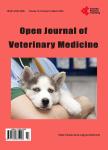Prevalence and Risk Factors of Gastrointestinal Parasitic Infections in Small Ruminants in the Greek Temperate Mediterranean Environment
Prevalence and Risk Factors of Gastrointestinal Parasitic Infections in Small Ruminants in the Greek Temperate Mediterranean Environment作者机构:Department of Anatomy and Physiology of Farm Animals Faculty of Animal Science and Aquaculture Department of Anatomy and Physiology of Farm Animals Faculty of Animal Science and Aquaculture Agricultural University of Athens Athens Greece Department of Home Economics and Ecology Harokopio University Athens Greece Department of Meteorology and Climatology School of Geology Aristotle University of Thessaloniki Thessaloniki Greece
出 版 物:《Open Journal of Veterinary Medicine》 (兽医学(英文))
年 卷 期:2012年第2卷第1期
页 面:25-33页
学科分类:1002[医学-临床医学] 100201[医学-内科学(含:心血管病、血液病、呼吸系病、消化系病、内分泌与代谢病、肾病、风湿病、传染病)] 10[医学]
主 题:Risk Factors Gastrointestinal Parasites Sheep Goats Farm Greece
摘 要:Gastrointestinal (GI) parasitic infections of sheep and goats were investigated in 69 farms located in Thessaly region of Greece, characterized by temperate Mediterranean climate, during two consecutive seasons. A total of 557 fecal samples were collected. Helminth eggs were detected in 44 (7.9%) samples. Strongyle-type eggs were found in 19 (3.4%) samples, Nematodirus spp. eggs in 6 (1.1%) samples, Trichuris spp. eggs in 16 (2.9%) samples, Fasciola hepatica in 3 (0.5%) samples, and Dicrocoelium dendriticum in 1 (0.2%) sample. Coccidian oocysts were found in 36 (6.5%) samples. Risk factors related to animal and farmer status, farm and pasture management, and environmental factors derived by satellite data were examined for their association with the prevalence of helmith infections. A logistic regression model showed that the educational level of farmers and the elevation of farm location were associated with helminth



